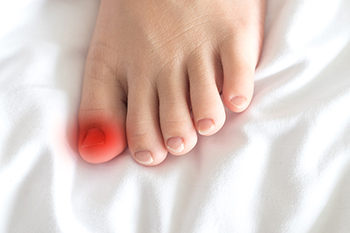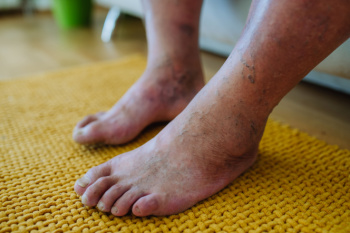July 2025

An ingrown toenail occurs when the edge of the toenail grows into the surrounding skin, leading to pain, redness, and swelling. Common causes include improper nail trimming, tight footwear, or toe injuries. Risk factors include poor foot hygiene, curved toenails, and certain genetic traits. Symptoms may involve tenderness, infection, or drainage surrounding the nail. Left untreated, the condition can worsen and impact daily activities. A chiropodist can provide expert care by relieving pain, addressing the cause, preventing recurrence through proper foot care education, and, if needed, minor procedures. If you are experiencing discomfort or notice signs of an ingrown toenail, it is suggested that you schedule an appointment with a chiropodist who can effectively treat this uncomfortable condition.
Ingrown toenails may require medical attention. If you have significant pain or notice signs of infection from an ingrown toenail, please consult with one of the chiropodists from The Footcare Centre. Our chiropodists will assess your condition and provide you with quality foot and ankle treatment.
What Is an Ingrown Toenail?
An ingrown toenail occurs when the edges of a toenail grow into the surrounding skin. The toenails of the big toe are usually affected, however, an ingrown toenail can happen on any toe. Sometimes, the area can become infected leading to potentially serious complications. The ingrown toenail may be caused by improper trimming of the toenail, wearing ill-fitting shoes, or injury to the nail.
Symptoms
The symptoms of an ingrown toenail include:
Pain
Swelling
Redness
Warmth
Pus or drainage from the affected nail or a fever may indicate an infection of the area.
Treatment
Treatment depends on the severity of the ingrown toenail. In less severe cases, home treatment may be adequate. Soaking the affected foot in warm water and gently lifting the nail from the skin with a piece of clean cotton can help. In more severe cases, you may need to use topical or oral antibiotics to treat an infection. Surgical removal of the ingrown toenail may be required if more conservative treatments fail.
Ingrown toenails may be prevented by wearing well-fitted shoes and properly trimming the toenails. Toenails should be trimmed straight across and not too short when using nail clippers.
If you have any questions, please feel free to contact our office located in . We offer the newest diagnostic and treatment technologies for all your foot care needs.

Diabetic patients can develop symptoms in their feet, such as numbness, tingling, burning sensations, slow-healing sores, or changes in skin color and temperature. These signs may indicate nerve damage or poor circulation, both common complications of diabetes. Proper care includes daily foot checks, gentle washing and drying, moisturizing dry areas, and wearing well-fitted shoes to prevent pressure points. Additionally, avoid walking barefoot to reduce the risk of injury. A chiropodist plays a key role in monitoring foot health, treating wounds, and managing nail or skin conditions to prevent serious complications. If you have diabetes, it is suggested that you schedule regular visits with a chiropodist to ensure your feet remain healthy and protected from diabetes-related damage.
Diabetes can cause serious problems in the lower limbs if proper preventive measures are not taken and diabetic wound care is not performed. If you would like to learn more about caring for diabetic feet, please consult with one of the chiropodists from The Footcare Centre. Our chiropodists can help you maintain the health of your lower limbs and your mobility.
Diabetes can lead to a host of foot and ankle complications, including:
Poor circulation
Peripheral neuropathy
Diabetic foot wounds and ulcers
Infection
Corns and calluses
Dry, cracked skin
Nail disorders
Hammertoes
Bunions
Charcot foot
If you have diabetes, you must be vigilant of any changes in your foot health. This is best done through daily foot inspections. Using a mirror to help you if necessary, look for any:
Cuts, scrapes, sores, or wounds
Bruising or discoloration
Swelling
Rash
Foul odor
Nail changes
Hair loss
Warmth and inflammation
Deformities
Lower limb pain
Strange sensations (numbness, tingling, burning, pins, and needles)
If you detect anything unusual, seek the care of a chiropodist as soon as possible. If you have any questions, please feel free to contact our office located in . We offer the newest diagnostic and treatment technologies for all your foot care needs.

Proper foot placement is key to running efficiency and injury prevention. Runners benefit from keeping their feet parallel rather than angled outward, which promotes better alignment and balance. A midfoot landing, rather than a heel strike, distributes force more evenly and reduces strain on joints. Straight leg heel strikes may slow momentum and increase the risk of injury. A chiropodist can assess gait, recommend improvements, and provide orthotics to support proper alignment. If you have sustained a foot injury or have experienced discomfort or inefficiency during running, it is suggested that you contact a chiropodist who can guide you toward improved technique and better performance.
The biomechanics of your feet play an important role in your foot health. To learn more, please consult with one of the chiropodists from The Footcare Centre. Our chiropodists can help you maintain the health of your lower limbs and your mobility.
Foot biomechanics refers to the study of the structure, function, and motion of the feet. The feet and ankles are a complex system consisting of many bones, joints, ligaments, muscles, and tendons that work together to move your feet. Understanding the unique biomechanics of your own feet can help you and your chiropodist make informed decisions about your foot health care. This includes decisions about the best preventive measures to avoid foot pain, the best treatment options for various foot problems, and finding the best shoes for your feet.
If you have any questions, please feel free to contact our office located in . We offer the newest diagnostic and treatment technologies for all your foot care needs.
Blog Archives
- 2025
- 2024
- 2023
- 2022
- 2021
- 2020

